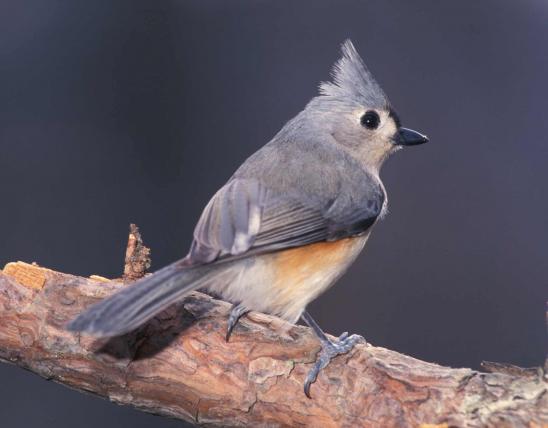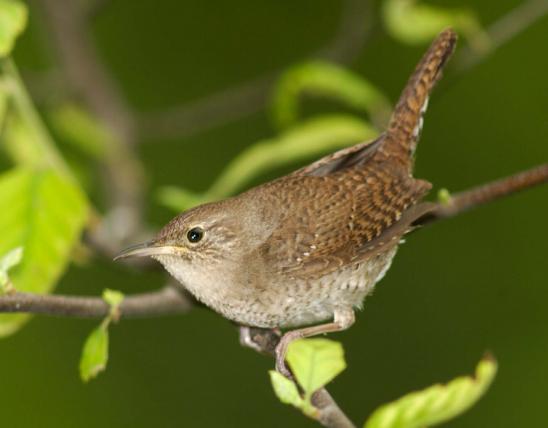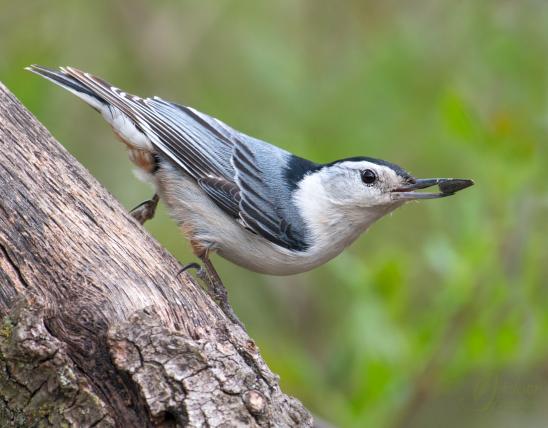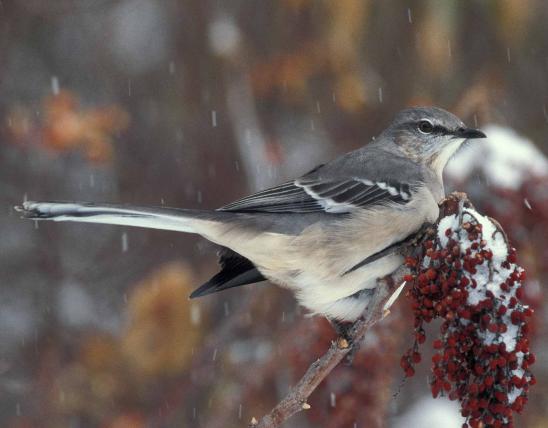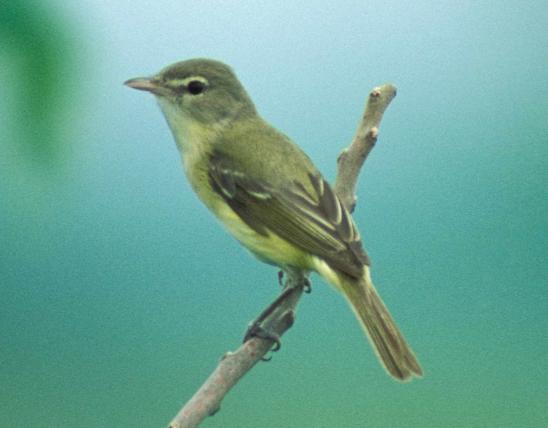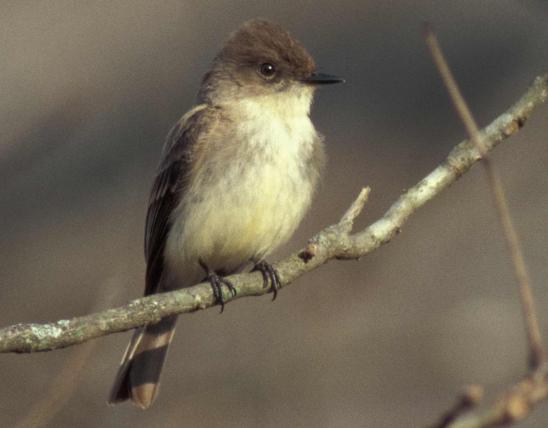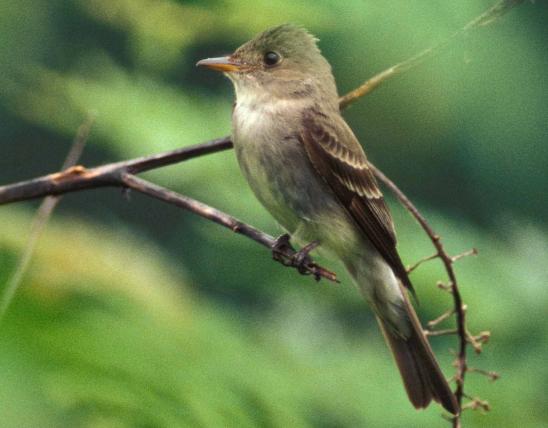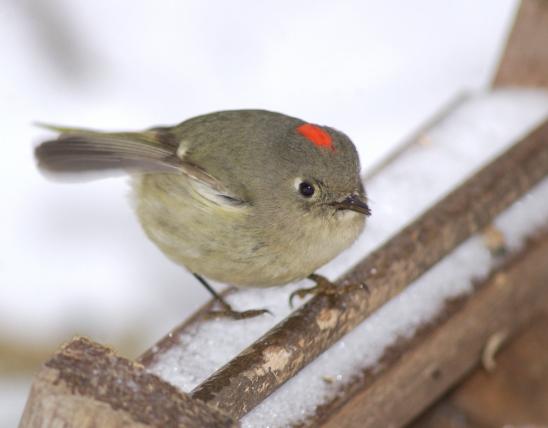
Blue-gray gnatcatchers are dainty, small, gray birds with thin, sharp bills; they seem like wrens or warblers. They are common summer residents in Missouri. They habitually jerk their tails from side to side.
The upperparts are bluish gray in males and gray in females; there is a white eye ring, and the tail is black. The underparts are pale gray. The outer tail feathers are white, which makes the tail appear mostly white from below, when the tail is closed. The male has a black eyebrow in breeding season. Like Bewick’s wrens, blue-gray gnatcatchers habitually jerk their tails from side to side; they also commonly hold their tail cocked upright. The song is a series of buzzy, wheezy, squeeky, chattering warbles, often sounding insectlike. The call is an extended buzzy pzeeee.
Length: 4½ inches (tip of bill to tip of tail).
Statewide, in appropriate habitats.
Habitat and Conservation
In summer, look for blue-gray gnatcatchers in forests, woodlands, swamps, and shrubby areas. They are especially fond of moist, low areas such as bottomland forests and wetlands. These are active birds that hop around rapidly on branches and amid leaves as they look for insects and spiders.
Food
Forages in wooded and shrubby habitats and swamps for insects, spiders, and their egg cases. Like American redstarts, they sometimes capture insects in the air (a foraging behavior called hawking); they also will hover over leaves as they capture prey. If an insect is too large to swallow whole, the gnatcatcher removes the wings from the prey and whacks it on a branch before consuming it.
Despite the name, gnats (small true flies such as fungus gnats, wood gnats, black flies, and biting midges like no-see-ums) are not a large part of the diet.
Status
Common summer resident; accidental winter visitor, mostly in southeast Missouri.
Taxonomy: The gnatcatcher family (Polioptilidae) occurs in North and South America and has approximately 21 species in 3 genera. Their closest relatives are the New World wrens (family Troglodytidae). Before the gnatcatcher family was created, its members used to be included in family Sylviidae, a group of about 25 species of Old World warblers and babblers; that family now is limited to birds occurring in Eurasia and Africa.
Life Cycle
Present in Missouri from late March through mid-September; populations are highest from mid-April through late August. The breeding territory includes most of the eastern United States, the US southwest, and Mexico. The US breeding populations migrate south to spend winters in Mexico, Central America, the Caribbean, and along the extreme southern border of the United States.
Males and females build the nest together, and both share in the work of feeding and tending the young. Like ruby-throated hummingbirds, they construct cup nests from spider silk and bits of fine plant material and decorate them with lichens. The lichen and bark decorations help camouflage the nest from potential predators. The nests are built on branches, rather far away from the trunk of the tree. A pair of gnatcatchers may build several nests over the course of the season, in part to escape problems of nest parasites.
There may be 1 or 2 broods in a nesting season. Clutches comprise 3–5 eggs and are incubated 11–15 days. After hatching, the young start leaving the nest after 10–15 days. Lifespan can exceed 4 years.
Human Connections
Gnatcatchers serve an important role in helping to control populations of the insects and spiders they eat. People appreciate this natural, nontoxic pest-control service. Birds appreciate the seasonal abundance of insects in our part of the world, because they need thousands of insects to feed their young. People can help by planting (and tolerating) native wildflowers and other plants, which feed Missouri’s moths, beetles, and other insects the birds require.
Blue-gray gnatcatchers are fun to watch as they hop around and wag their tails. With their cool gray colors and long, cocked-up, white-edged tails, they have been likened to tiny mockingbirds. Their insistent, lengthy, buzzy songs, which incorporate portions of other birdsongs, are also a bit like mockingbirds’.
Researchers have shown that the fortunes of gnatcatchers and other birds that use lichens to camouflage their nests are linked to the survival of lichens. Coal-burning power plants used to emit high levels of sulfur dioxide, an air pollutant that causes acid rain. In some areas of the country, acid rain killed off many of the lichens that grow on tree branches, and these birds’ nesting success also declined. When the government, though the Clean Air Act and related legislation, regulated industries to reduce the pollutants that cause acid rain, the lichens returned — and birds’ nesting success rebounded, too.
The blue-gray gnatcatcher is Missouri’s only gnatcatcher, but if you travel to the US southwest, you may see some other species: the black-tailed gnatcatcher, the black-capped gnatcatcher, and the California gnatcatcher. Birders travel to bird-watching hotspots in southern California, Arizona, New Mexico, and Texas to see these and many other principally Mexican species whose range overlaps north of the border.
Ecosystem Connections
Gnatcatchers serve an important role in helping to control populations of the insects and spiders they eat. This is important for the health of forests, and they capture many insects that are tree pests. They eat many caterpillars and other larvae that chomp tree leaves.
A primary reason for birds to migrate is so they can take advantage of the explosion of insects that happens each spring and summer in a region that is nearly devoid of insects in the winter. Most birds need protein-rich insects to feed their growing nestlings. Rather than stay in regions where it is warm year-round, where insects are available in all seasons, many gnatcatchers and other birds move north where there is less competition for territory and the multitudes of precious, nutritious bugs.
Gnatcatchers are limited to eating insects and other small invertebrates; they cannot switch to seeds or fruits during the winter, so they must migrate south in winter to areas where insects remain available. Many gnatcatchers stay in Mexico to raise their young. So what should we consider the “home” of this species? Where they go temporarily, to build nests and raise their young, or where they can live year-round?


















About 350 species of birds are likely to be seen in Missouri, though nearly 400 have been recorded within our borders. Most people know a bird when they see one — it has feathers, wings, and a bill. Birds are warm-blooded, and most species can fly. Many migrate hundreds or thousands of miles. Birds lay hard-shelled eggs (often in a nest), and the parents care for the young. Many communicate with songs and calls.























